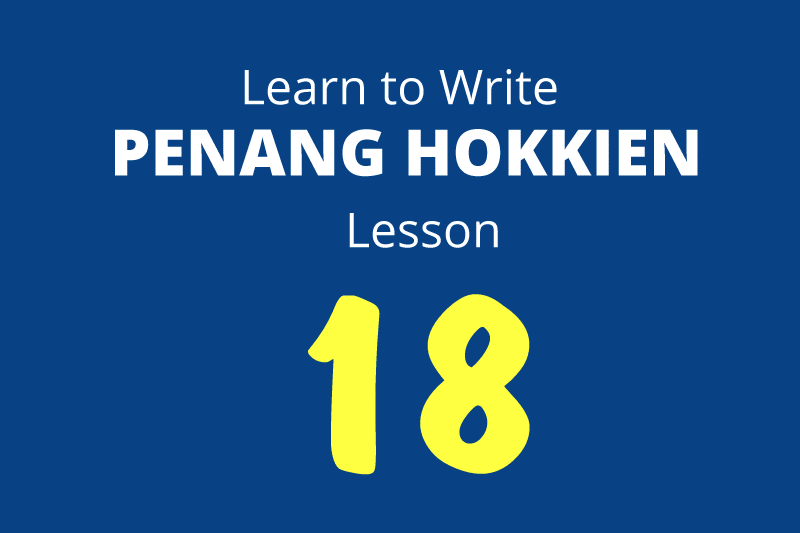
The particle "-eh2" is a very common word in Penang Hokkien. It appears at various instances serving various functions. The use of "-eh2" can be grouped into three main functions.
Two of these we have encountered in earlier lessons, and here let's do a recap.
- We use "-eh2" to show possession. It is hyphenated to the possessee if followed by the possessor. It is always hyphenated to the personal pronoun (I, you, we, etc.) to form the possessive pronoun (mine, yours, ours, etc.).
Ah3 Hock3-eh3 chia.
Ah Hock's car.
Wah1 yong33 Ah3 Hock3-eh2.
I use Ah Hock's.
Wah1-eh3 chu3.
My house.
Cit1-leh1 bo33 si33 wah1-eh2.
This hat is mine.
Tok1teng4-eh3 kha1.
The leg of the table.
Sna1-eh3 seik3.
The colour of the dress.
Cit1-leh1 lien4 si33 heh1-leh1 chia1-eh2.
This wheel belongs to that car.
Often, the use of "-eh2" in this position is to purpose, as in "for something".
Ciak3 pnui33-eh3 pnua2.
Dinner plate (literally, "plate for eating rice", not "plate that eats rice")
Ciak3 pnui33-eh3 tok1teng4.
Dining table (literally, "table for eating rice", not "table that eats rice")
lim3 thng1-eh3 thau3keong1.
Spoon for drinking soup (literally "spoon for drinking soup", not "spoon that drinks soup")
Sio3tau1cau4-eh3 eh2.
Running shoes (not "shoes that race each other") - We use "-eh2" with classifiers. It translates as "of" in English. Where a noun which is not usually a classifier is used as one, the "-eh3" is necessary.
Wah1 ciak3 cit3-tay3-eh3 lo3ti1. (Alternatively: Wah1 ciak3 cit3-tay1 lo3ti1.
(Alternatively: Wah1 ciak3 cit3-tay1 lo3ti1.  )
)
I ate a piece of bread.
Ee1lang2 beh4 nor33-kuan3-eh3 gu3leng2. (Alternatively: Ee1lang2 beh4 nor33-kuan1 gu3leng2.
(Alternatively: Ee1lang2 beh4 nor33-kuan1 gu3leng2.  )
)
They bought two bottles of milk.
Sna3-keng1-eh3 chu3 tiok3 sio1. (Alternatively: Sna3-keng3 chu3 tiok3 sio1.
(Alternatively: Sna3-keng3 chu3 tiok3 sio1.  )
)
Three houses were burnt down.
Ie1 to3 ha1kark1 cit3-pun1tau4-eh3 sam3pah4. (No alternatives.)
He disposed a dustpan of trash.
(No alternatives.)
He disposed a dustpan of trash.
Ee1 say4 cit3-bin33phun2-eh3 tau33. (No alternatives.)
(No alternatives.)
She washed a basin of beans.
The antecedent is often dropped if it is understood, and in the English translation, replaced with "one".
Wah1 beh4 pan3gee2-eh2. I bought the cheap one.
I bought the cheap one.
Wah1 boek3 ho4-eh2. I want a good one.
I want a good one.
Lu1 boek1 tng2-eh2 a33si33 tay4-eh2?
Do you want the long one or the short one?
Now let's look at the third use of "-eh2". We use it also as a "relative pronoun" and "subordinate conjunction". This is when we want to provide additional details. The subordinate conjunction creates a subordinate clause, an incomplete sentence, which requires a main clause to form a complete sentence.
Cit1-ciak1 ciau4 ciak3 hu2.
 This bird eats fish.
This bird eats fish.Cit1-ciak1 ciak3 hu2-eh3 ciau4.
 (subordinate clause)
(subordinate clause)This cat who/that eats fish. (Or, "This fish-eating bird")
Cit1-ciak1 ciak3 hu2-eh3 ciau4 lam3 seik3.
 (complete sentence)
This bird that eats fish is blue in colour. (Or, "This fish-eating bird is blue in colour.")
(complete sentence)
This bird that eats fish is blue in colour. (Or, "This fish-eating bird is blue in colour.")Wah1-eh3 liak3 hu2-eh3 bang33 phua3 liau4.
 (Comprises "Wah1-eh3 bang33 phua3 liau4" and "liak3 hu2 eh2")
(Comprises "Wah1-eh3 bang33 phua3 liau4" and "liak3 hu2 eh2")My net for catching fish is torn. (Comprises "My net is torn" and "for catching fish")
Wah1-eh3 say1 pnua3wna4-eh3 chooi4 leow4 liau4.
 (Comprises "Wah1-eh3 chooi4 leow4 liau4" and "say1 pnua3wna4 eh2")
(Comprises "Wah1-eh3 chooi4 leow4 liau4" and "say1 pnua3wna4 eh2")My dishwashing liquid is finish. (Comprises "My liquid is finish" and "for washing dishes")
It is a common sentence construction to place "-eh3" at the end, as an emphatic particle, that is, to provide emphasis to what is being said.
Mummy, ie1 phak3 wah4 eh2!

Mummy, he beat me! (Literally "Mummy, he's the one who beat me", but often translated as "Mummy, he beat me one!")
Mm33thang3 kae1 mm33 cai1 eh2!

Don't pretend not to know (one)!
Heh1-leh1 gin1na4 luan33-luan33 kong1wa33 eh2.

That child speaks nonsense (one).
Ee1 hnua33 cin3 ban33 eh2!

She drives so slowly (one)!
Previous Lesson | Main Page | Next Lesson
Language Learning Tools
Use the following language learning tools to learn Penang Hokkien!Learn Penang Hokkien with uTalk
This app opens the door to over 150 languages.Return to Penang Hokkien Resources

Copyright © 2003-2025 Timothy Tye. All Rights Reserved.

 Go Back
Go Back
